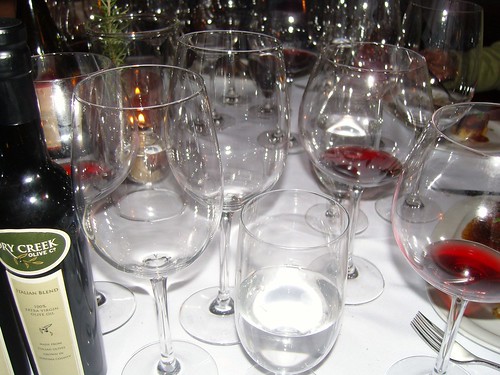Image via martinvarsavsky's flickr.
I had always wondered if buying better and more expensive glassware for wine made a difference. Glassware makers like Riedel (pronounced Ree-del) always claim it does. They offer the wisdom that the shape of the glass can direct the flow of the wine over your tongue helping to emphasize certain characteristics of the wine such as acid which you reportedly feel on the sides of your tongue. However, the idea of the tongue map (where you taste sweet, bitter, acid and salty on different areas of the tongue) has long been debunked.
So I signed up for one of Riedel's glass tasting classes with more that a little skepticism. But it didn't take long to be humbled by what I learned. The tasting started with sitting in front of 5 glasses: one plastic beer cup, one standard restaurant glass, one Burgundy glass, one Bordeaux glass, and one Montrachet (Chardonnay) glass.
Our first taste was of a French Chardonnay from the Montrachet glass, which was balanced and delicious. It highlighted both the acid and the sweetness. Second we tasted the same wine from the plastic cup: it became harsh and almost burned the back of my throat, highlighting the alcohol. To make matters worse, you could not smell the wine. The same was true of the standard restaurant glass.
Next we tasted a Burgundy (Pinot Noir), full of fruit with a smooth texture and finish. When we tasted the Burgundy from the Montrachet glass, the wine lost its balance. Now it tasted green and acidic. When we tasted it from the restaurant glass, the tannins were enhanced and the wine was astringent.
And so the night went. I won't bore you with anymore details of wines and glasses, but needless to say the night made a believer out of me. I've repeated this experiment many times over for others (albeit on a smaller scale) and have convinced many of them as well. So how do you pick out wine glasses? Here are a few tips and guidelines I've come across:
- Buy glasses with a large enough bowl to swirl the wine in. I get irked when a restaurant uses a small wine glass and then fills it virtually to the rim. One of the great pleasures of wine is the smell and if you can't swirl the wine and then get your nose into the glass, then you can't smell it well. Look for a minimum of 10 ounce glasses and then fill it a little less than half way full. That empty space inside the glass is where all the good stuff happens.
- Look for glasses that taper to the top. This allows for the aromatics to collect in the glass, enhancing your experience. Both the plastic beer cup and standard restaurant glass at the Riedel tasting had straight sides. This really dulled the aromatics to the point where you really couldn't smell much from the wine.
- Look for thin rims, preferably polished cut rims versus rolled. I know, it sounds like I'm being a bit too picky here, but I think this matters more than what the glass is made of. A thin glass will allow for the wine to glide into your mouth where as a thick glass kind of sloshes it in there.
- Spend about as much on a glass as you would on a bottle of wine. This advice makes sense to me, in fact, it even makes sense to spend a bit more. My rationale is this, if I can enhance a cheaper wine with a glass, then I get more bang for my buck out of every wine I buy.
I am, however, partial to glasses with stems. The Riedel stemless O series are very popular, but I find holding them awkward and don't enjoy all the fingerprints that wind up on the glass after only a few drinks. I also prefer real glass over plastic, but truth be told, neither substance will affect the taste or smell of the wine.
At the end of the day, you can enjoy wine from a jelly jar, a mason jar or that plastic beer cup if that's what you have on hand. After all, it's about the wine, not the glass. Oh, and those $100 stems I received. . .
they sit on the shelf, untouched. I'm too afraid I'll break them.
Cheers,
Sandy

Thank you for the first hand clarification on an open question of mine for a long time. I guess I will have to look at what types of glassware I am missing in my collection now.
ReplyDeleteJason
So interesting! And, thankfully I have the same C&B glasses as you recommend. And, the idea of wine out of a mason jar makes me chuckle. Awesome post Sandy!
ReplyDeleteInteresting! We ended up getting the glasses Riedel sells at Target, affordable & really nice
ReplyDelete